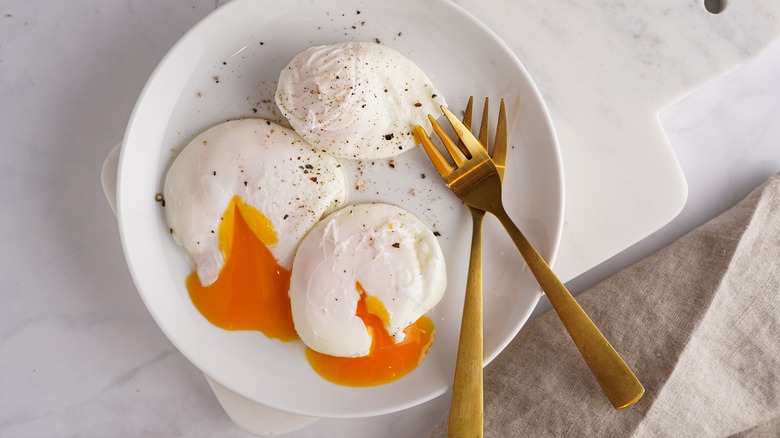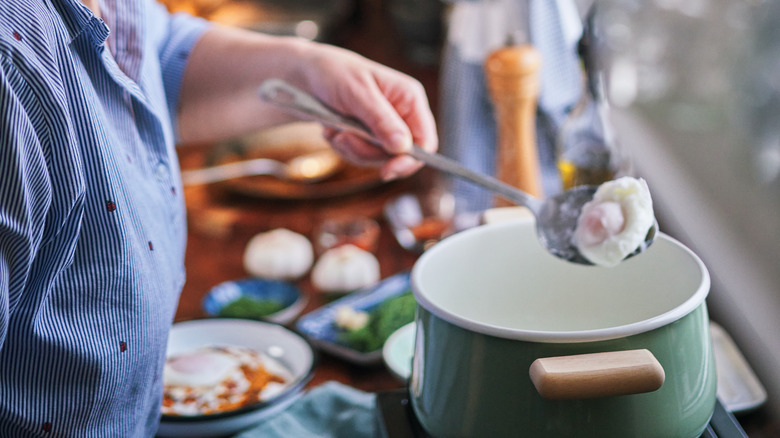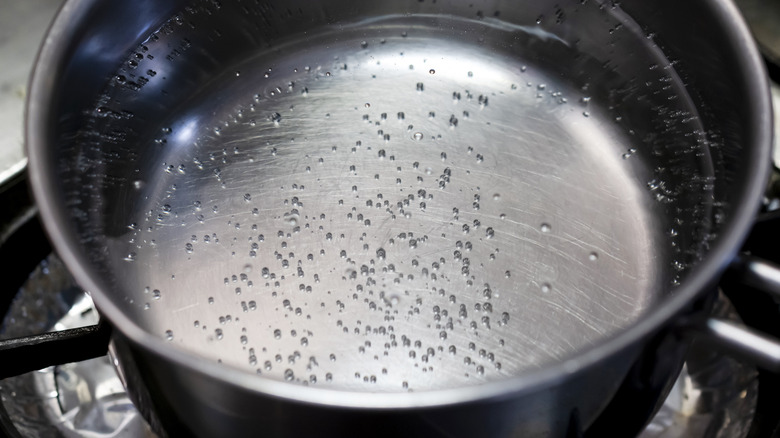Top Chef Winner Mei Lin's Hack For Making Poached Eggs In Bulk
If you're hosting brunch or serving breakfast for dinner, you may have experienced the poached egg conundrum that feels like an SAT problem. If you have 5 people expecting two poached eggs each but can only poach one egg at a time, how long will it be before everyone is served — and will the first person's eggs be cold if they wait to eat as a group?
Instead of getting bogged down with math, there's another solution to the problem: Poach the eggs in bulk with a few important tips to make it easy peasy. No whirlpools, no messy egg whites, no little cling film egg poaching packets, no problem. The two main points to this bulk egg poaching hack are to cure the eggs in a diluted vinegar solution and to cook them gently in a large, shallow pan of not-quite-simmering water.
@foodnetwork counting down our top videos of 2023 – #5 @Mei Lin's mind blowing hack for making poached eggs in bulk 🤯
Mei Lin, internationally acclaimed chef and Top Chef winner, likes to start prepping her poached eggs about 30 minutes before she starts cooking them by cracking them into a bowl of two parts water to one part vinegar. In a TikTok for The Food Network, she explains that this creates a film that holds the structure of the egg white together. By putting the eggs in just barely bubbling water instead of a rolling simmer, they aren't agitated. The result is not only a whole batch of poached eggs ready to serve at the same time but also maybe the prettiest poached eggs you've ever made.
Curing eggs in a vinegar solution
The curing step might be a little unusual to the standard home cook, but there's science behind it. Egg whites are made up almost entirely of protein, with a little bit of water. There are two ways to denature proteins: Through heat or — as anyone who has ever eaten ceviche knows — through acid. By resting the eggs in an acidic liquid, the proteins in the exterior film of the egg white start to denature and link together, creating a barrier that holds the egg white together.
If you've poached eggs without doing this, you've likely seen the egg whites spread and ribbon out once they hit the hot water. It's a bit of a mess, it wastes eggs, and it makes it difficult to identify where one egg ends and another begins if you cook more than one at a time. The whirlpool technique, where you use a spoon to swirl the water into a little whirlpool, is meant to help keep the egg whites tight to the egg, but it also makes it nearly impossible to effectively cook more than one egg at a time.
One of the main concerns about this method is whether or not the eggs take on the flavor of vinegar. The comments in the TikTok of Mei Lin posted by The Food Network discuss this briefly. Some folks claim that they don't taste the vinegar at all, others taste it a little bit, while some find it overpowering.
The voracity of the water is important
Eggs are meant to be poached at a simmer, but the range of temperatures and bubble action in what's known as a simmer can vary wildly. When eggs are added to the water, they get tossed around by the bubbles that rise. The bigger the bubble, the more movement there is in the water — and the more disruption to the egg.
We know that a full boil is achieved at 212 F. But the stage of a simmer spans from 140 to 195 degrees. From 140 degrees to 170 degrees is a stage known as a quiver simmer, where little bubbles will form but not break to the surface. That's the temperature range you're going for here for gently poached eggs, and the temperature Mei Lin demonstrates in her video.
Egg whites cook between 144 F to 149 F, and egg yolks cook from 149 F to 158 F. Your water doesn't need to be so hot that it's bubbling ferociously; in fact, this can lead to overcooked, rubbery egg whites and chalky yolks instead of beautiful, tender poached eggs. With enough patience (it really doesn't take much more patience, and you're rewarded with less anxiety about overcooking the eggs), your eggs will poach perfectly in a quiver simmer — and because they're not bouncing all over the place, it's the proper environment for multiple eggs to poach at once.


